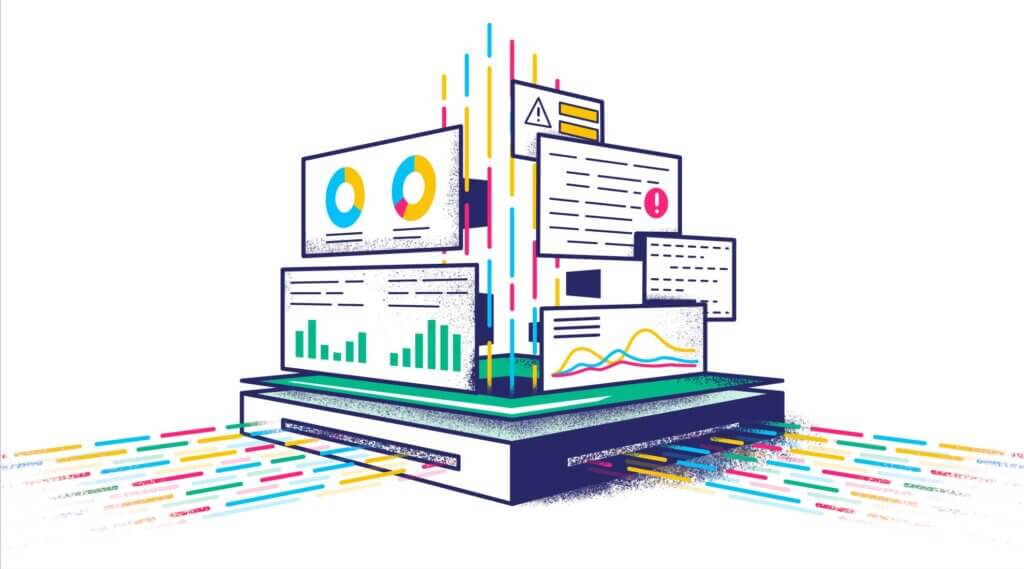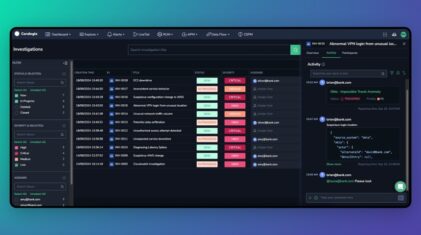Modern day Security Information and Event Management (SIEM) tooling enterprise security technology combine systems together for a comprehensive view of IT security. This can be tricky, so we’ve put together a simple SIEM tutorial to help you understand what a great SIEM provider will do for you.
A SIEM’s responsibility is to collect, store, analyze, investigate and report on log and other data for incident response, forensics and regulatory compliance purposes. This SIEM tutorial will explain the technical capabilities that a SIEM provider should have.
Technical Capabilities of Modern SIEM Providers
Data Collection
One of the most understood SIEM capabilities, data collection or log management, collects and stores the log files from multiple disparate hosts into a centralized location. This allows your security teams to easily access this information. Furthermore, the log management process can reformat the data it receives so that it is all consistent, making analysis less of a tedious and confusing process.
A SIEM can collect data in several ways and the most reliable methods include:
- Using an agent installed on the device to collect from
- By directly connecting to a device using a network protocol or API call
- By accessing log files directly from storage, typically in Syslog format or CEF (Common Event Format)
- Via an event streaming protocol like Netflow or SNMP
A core function of a SIEM is the ability of collecting data from multiple devices, standardizing it and saving it in a format that enables analysis.
Advanced Analytics
A SIEM tool needs to analyse security data in real time time. Part of this process involves using ‘Advanced Analytics’. SIEM or ‘Next Gen SIEM’ tools of today, have been extending their capabilities to more frequently include analytics functions. These automated analytics run in the background to proactively identify possible security breaches within businesses’ systems. An effective SIEM provides advanced analytics by using statistics, descriptive and predictive data mining, machine learning, simulation and optimization. Together they produce additional critical insights. Key advanced analytics methods include anomaly detection, peer group profiling and entity relationship modeling.
New methods, modeling or machine learning techniques for generating these analytics, can be defined using SIEM tooling services from query editors (using KQL – Kibana Query Language), UEBA (User Entity Behavioral Analytics) and EBA (Entity Behavior Analysis) models. All configurable through user interfaces and can be managed using prebuilt or custom incident timelines. They can flag anomalies and display details of an incident for the full scope of the event and its context.
As these analytics functions become more standard, some SIEM vendors are pairing the traditional log collection with threat detection and response automation. This is key to producing insights from high volumes of data, where machine learning can automate this analysis to identify hidden threats.
Advanced Threat Detection
Security threats will continually evolve. A ‘Next Gen’ SIEM should be able to adapt to new advanced threats by implementing network security monitoring, endpoint detection and response sandboxing and behavior analytics in combination with one another to identify and quarantine new potential threats. Security teams need specialized tools to monitor, analyze and detect threats across the cyber kill chain. A cyber kill chain being the steps that trace stages of a cyberattack from the early reconnaissance stages to the exfiltration of data. By configuring machine learning and search context analytics services, you can realize a risk-based monitoring strategy that automatically identifies and prioritizes attacks and threats, that the security team can quickly spot and investigate true dangers to your environment.
These are configurations that can be defined in modern day SIEMs, and will result in real time threat detection monitoring of endpoints from anti-virus logs, insecure ports to cloud services. The set goal of threat detection should be not only to detect threats, but also to determine the scope of those threats by identifying where a specific advance threat may have moved to after being initially detected, how that threat should be contained, and how information should be shared.
Incident Response
Our SIEM tutorial wouldn’t be complete without this feature. Incident response is an organizational process that allows security teams to contain security incidents or cyber attacks and prevent or control damages. Many organizations need to develop proactive incident response capabilities that will actively search corporate systems for signs of a cyber attack. Threat hunting is the core activity of proactive incident response, which is carried out by security analysts. It typically involves querying security data using a SIEM, and running vulnerability scans or penetration tests against organizational systems. The objective is to discover suspicious activity or anomalies that represent a security incident.
An effective incident response strategy needs a robust SIEM platform to identify, track and reassign incidents. This can add the capability of automation and orchestration to your SOC (Security Operation Center) making your cyber security incident response team more productive. A SOC can use customizable tools in the SIEM, designed for security incidents, ensuring that threats do not slip through the cracks.
Other key capabilities should include the ability to either manually or automatically aggregates events, support for APIs that can be used to pull data from or push information to third-party systems, an ability to gather legally admissible forensics evidence, and playbooks that provide organizations with guidance on how to respond to specific types of incidents. SIEM solutions should display the security information in a simple format, such as graphics or dashboards.
SOC Automation
Modern day SIEMs will leverage Security Orchestration and Automation (SOAR) technology that helps identify and automatically respond to security incidents, and supports incident investigation by SOC team members. The foundational technology of a SOC is a SIEM system. The SIEM will use statistical models to find security incidents and raise alerts about them. These alerts will come with crucial contextual information. A SIEM functions as a ‘single pane of glass’ which enables the SOC to monitor enterprise systems.
Monitoring is a key function of tools used in the SOC. The SOC is responsible for enterprise-wide monitoring of IT systems and user accounts, and also monitoring of the security tools themselves. An example is ensuring antivirus is installed and updated on all organizational systems. The main tool that orchestrates monitoring is the SIEM.
SOC automation benefits from SOAR integration with SIEM. A SOAR platform will take things a step further by combining comprehensive data gathering, case management, standardization, workflow and analytics to provide organizations the ability to implement sophisticated defense-in-depth capabilities. A SOAR’s main benefit to a SOC, is that it can automate and orchestrate time-consuming, manual tasks using playbooks, including opening a ticket in a tracking system, such as JIRA, without requiring any human intervention. This would allow engineers and analysts to better use their specialized skills.
All in all…
SIEM tools are proving to be more important than ever in modern times of cyber security. They are becoming undeniably useful in being able to draw together data and threats from across your IT environment into a single easy-to-use dashboard. Many of ‘Next Gen SIEM’ tools are configured to flag suspect patterns on their own and sometimes even resolve the underlying issue automatically. The best SIEM tools are adept at using past trends to differentiate between actual threats and legitimate use, enabling you to avoid false alarms while simultaneously ensuring optimal protection.
This SIEM tutorial was aimed at providing context and clarity to the role of an effective SIEM provider. Any provider that is missing these capabilities should be investigated, to ensure they’re the right fit for you and your security operations.




